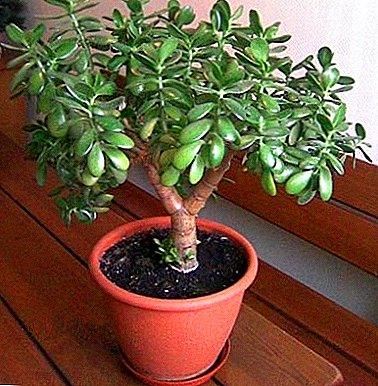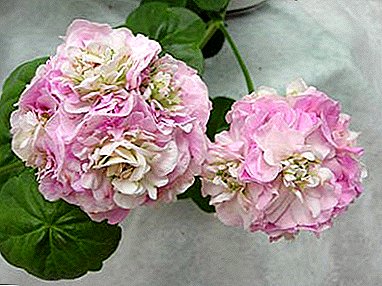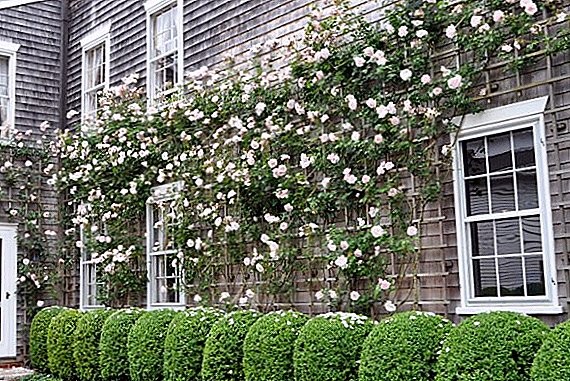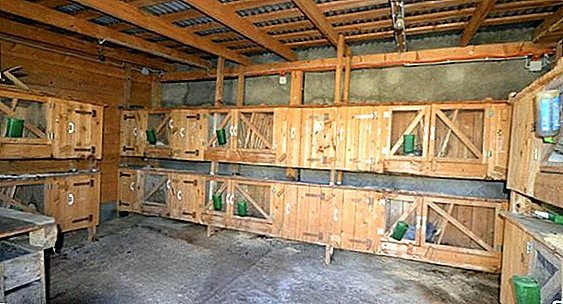 People who do not have a country house or a summer cottage can accommodate a garage room for breeding rabbits.
People who do not have a country house or a summer cottage can accommodate a garage room for breeding rabbits.
This is a good alternative for residents who would like to engage in rabbit breeding.
Pros and cons of breeding rabbits in the garage
Doing a rabbit breeding business in a garage is quite a profitable business. Denote the main advantages of growing rabbits in the garage:
- guaranteed a high rate of profitability;
- constant steady income;
- relatively low costs at the initial stage of business organization;
- short payback period;
- Breeding rabbits for yourself is a profitable occupation that regularly provides healthy dietary meat, fur and skins.
 Housekeepers should take into account some of the difficulties of breeding rabbits in the garage:
Housekeepers should take into account some of the difficulties of breeding rabbits in the garage:- strict hygienic and quarantine requirements for the room where animals of different age groups are kept (and this is a tangible time cost);
- frequent pet diseases;
- strict accounting and control of the livestock formation process, conducting work on the correct process of crossing rabbits;
- the need for a separate cage for each head, except for young.
Did you know? Rabbits have 28 teeth. They chew 120 times a minute and have more than 17 thousand taste buds.
What to consider when breeding rabbits in the garage
Earthing cages in the garage should be comfortable and easy to maintain. Consider what other conditions in the garage must be provided before you buy rabbits. 
Lighting
The first thing you will need to take care of the lighting room. Many business executives recommend opening the garage door during the warm time of the day, during cleaning or other actions. You can use ordinary LED lamps or special ones that create the effect of an artificial sun (turn them on for no longer than 10 hours a day).
Read about how to breed rabbits in the pit.
However, on hot summer days, the animals will hide from direct sunlight, so it is important to take care of the absence of bright sunlight during this period.
Air temperature and humidity
In the garage, rabbits need to ensure normal humidity and avoid sudden changes in temperature in the room. Optimum humidity - 60-70%.  With regard to temperature, it is desirable to comply with the average - from +10 to +20 ° C. In such conditions, the heat transfer of the body of animals is only 20-25%. In order to maintain the optimum temperature, it is recommended to install heating in the garage in the winter. Increasing the temperature in the room, these animals suffer even worse than its decrease. At a stable temperature of +35 ° C, they overheat, especially in still and humid air, and die. Smooth microclimate will help to create insulation of garage doors with foam plastic, mineral wool. All joints between the sections need to be supplied with reliable seals (blow out foam) - this will help minimize the leakage of warm air from the garage.
With regard to temperature, it is desirable to comply with the average - from +10 to +20 ° C. In such conditions, the heat transfer of the body of animals is only 20-25%. In order to maintain the optimum temperature, it is recommended to install heating in the garage in the winter. Increasing the temperature in the room, these animals suffer even worse than its decrease. At a stable temperature of +35 ° C, they overheat, especially in still and humid air, and die. Smooth microclimate will help to create insulation of garage doors with foam plastic, mineral wool. All joints between the sections need to be supplied with reliable seals (blow out foam) - this will help minimize the leakage of warm air from the garage.
Get acquainted with the features of the rabbit captive content.
Air exchange
Great attention also needs to be paid to ventilation in the garage. In the absence of a ventilation system in a closed winter room, the smell of manure and urine will accumulate and remain inside. There will be a danger of increasing the concentration of ammonia vapors and hydrogen sulfide, which is very harmful for animals and quite unpleasant for the breeder. Proper ventilation and regular cleaning will eliminate this problem. You can install forced ventilation, using, for example, a duct fan with automatic mode on and off.
No drafts, rats and mice
When keeping rabbits in the garage, you can face such a dangerous nuisance as the appearance of rats and mice. Rodents tolerate various infections and can cause serious harm to the little rabbits. A prerequisite for the prevention of the appearance of these pests is regular garbage and rubbish collection. Keep your cages clean and close to the garage. Pay special attention to the storage location of food for rabbits, because rodents transmit diseases most often through food.
Important! Since rabbits can not stand the winds, it is necessary to ensure the almost complete absence of drafts in the garage room.
Choosing the right breed
The best and, accordingly, the most common breeds of rabbits are:
- Gray giant - a popular meat breed. The mass of adults can reach 6.5 kg.
- New Zealand red - early meat breed. Adults reach a mass of 5 kg.
- French ram - another meat breed, by the age of 4 months, the bunnies reach the “selling” mass, and the adults grow to 7 kg.
- Silver Rabbit - breed mainly meat direction. The average weight of adults is 4.5 kg, and their soft beautiful skin of uniform color is suitable for sale.
- White downy - a kind, valuable light and very elastic down. The average length of an adult rabbit is about 55 cm with a body weight of 4 kg.
- Black brown rabbit - meat and sandpaper, a characteristic feature of which are endurance and unpretentious eared in feed and care, and their skin has the original color, very similar to the color of the black fox. The meat has excellent taste and nutritional qualities.
- Soviet chinchilla - Meat-skinned breed, which has gained popularity among breeders due to the unique silver-blue color of fur. Adult rabbits weigh about 5-7 kg, their meat has a rather good taste characteristics.
- Butterfly - another meat-skinned breed. The fur of its representatives has black specks on a white background, resembling the wings of butterflies. In addition to high-quality fur, the breed is known for its soft juicy meat and high fecundity of females.








How to make cages for rabbits in the garage on the system Zolotukhina do it yourself
More than 30 years ago, N. I. Zolotukhin, a rabbit breeder, constructed a cage in which rabbits develop well and are practically not ill. Strictly following the instructions, you can easily recreate this model.
Design and dimensions
The considered cellular system has several features:
- 3 tiers of different sizes;
- convenient tilting feeder;
- sloping floors.
 Between the living parts of the cell are V-shaped senni.
Between the living parts of the cell are V-shaped senni.In the design there is no stationary queen cell. In winter, inside you can install a closed wooden box with a hole to enter the rabbit. In the summer, this “dwelling” gets out of the cage and the female organizes a nest on a bed of hay. The plot with young stock is protected from the adult zone by a usual board.
The width of the cage should be 2 m, height - about 1.5 m. Depth of construction - from 70 to 80 cm. Be sure to follow the recommendation for floor slope - from 5 to 7 cm. The area of the floor grid at the back wall in width should be 15-20 cm. The dimensions of the door are 40x40 cm, the approximate height of one tier is 50 cm.  1 - test door to the socket compartment; 2 - pole-stand; 3 - mesh door; 4 - drinking bowl; 6 - retractable feeder; 7 - nursery; 8 - watering hole. We also give the size of the drawer of the queen cell:
1 - test door to the socket compartment; 2 - pole-stand; 3 - mesh door; 4 - drinking bowl; 6 - retractable feeder; 7 - nursery; 8 - watering hole. We also give the size of the drawer of the queen cell:
- front wall height - 16 cm;
- rear wall height - 26 cm;
- floor and ceiling - squares with dimensions 40x40 cm;
- the opening for the rabbit entry height is 15 cm, width - 10-15 cm.

Materials and tools
Tools and materials that a cage cannot do without are:
- wooden boards with a thickness of 1.5-2 cm;
- dense sheet slate;
- sheet metal or tin;
- the grid is dense, welded;
- polycarbonate (or chipboard, board, plywood);
- nails, hammer;
- hooks on the door or wooden bars for latch and limit bars.
Read about rabbit cell types and rabbit construction stages.
Step by Step instructions
Now you can go to the direct manufacture of cells:
- Focusing on the above dimensions, make a wooden frame.
- Next, you need to cut out the doors and partitions for the mother liquor and make a winter box for the young. If you do not plan to make a separate box, provide a solid door without gaps on that part of the cage, where for the first 15 days of life there will be babies with a rabbit.
- The grid should be cut by the number of cells.
- Cut out the floor from dense sheet slate, it will simultaneously serve as a roof for the lower tier.
- Cut back polycarbonate.
- Next, along the edges of the cells, you need to fill the bars-limiters. Their height is 10 cm, width is up to 2 cm. The bar is packed along the junction with the front edge of the cage.
- Separate each tier in half, leaving a place in the middle for V-shaped hay tanks (their sizes are arbitrary).
- Fix the feeder on the door at an angle of 35 degrees. This should be done with the help of nails, which pierced the side walls. Holes in the walls under the nails do a little more than the diameter of the nail. In the middle of the tank set the grid.



Cell arrangement
Erected cages need to be equipped with everything necessary for a comfortable life of eared animals.
Food and drink devices are the same as those used for other types of farm animals, that is, standard nurseries, feeders and various types of drinkers. In the cages should always be fresh bedding of hay. Pre-inspect it to be free from mold.
Did you know? The oldest rabbit on the planet has lived for 19 years.
How to care for rabbits in the garage
Consider a few important rules regarding the care of rabbits in the garage room.
Cleaning and disinfection of housing, equipment
For cleaning in the garage, which is inhabited by eared animals, you will need special equipment: hard brushes, brooms, brooms, buckets, shovels. Equipment must be kept clean.
Cells and rabbitry need to be cleaned daily from waste products and accumulated food residues. Pet grooming also includes changing litter as it gets dirty. Cleaning of cells should be carried out at least 2-3 times a month.  Carry out preventive disinfection of cells twice a year (autumn and spring). Bleach in the form of a 10% solution is usually used for this purpose.
Carry out preventive disinfection of cells twice a year (autumn and spring). Bleach in the form of a 10% solution is usually used for this purpose.
Vaccination
First of all, we note that vaccinations do only healthy animals. Any suspicion of an ailment is a reason for isolating an individual. The sick animal is first treated and only then vaccinated.
Rabbits are susceptible to disease. To avoid problems in the future, animals need to be vaccinated, while strictly adhering to the veterinary vaccination schedule.  In the first 3-4 days after purchase, it is recommended that antiparasitic treatment be carried out as a preventive measure.
In the first 3-4 days after purchase, it is recommended that antiparasitic treatment be carried out as a preventive measure.
When the rabbit is 28 days old, they are vaccinated against myxomatosis. Used live vaccine B-82. A repeat procedure is required at the age of 120 days.
When young animals turn 45 days old, vaccination against VGBK is required. Vaccination is repeated at 6 months.
What to feed
In the summer, fluffies need fresh greens. In winter, the animals feed on dry and green hay. They prefer spruce food. You can offer them conifers and hardwoods. In addition, the menu may contain branches of fruit trees.
Find out which herbs can be added to the diet of rabbits, and which are dangerous for the eared organism.
Juicy food animals like fresh potatoes, carrots, legumes. In the diet should include organic supplements, silage, bran, granulated combined feed.  Rabbits cannot be fed with tomatoes, red beets, mushrooms, garlic, cherries, plums, avocados, figs, seeds, fruit pits, nuts, dried apricots, sugar, chocolate, bread, cookies, oatmeal, dairy and dairy products, soy products, turnips , sorrel, as well as white and red cabbage.
Rabbits cannot be fed with tomatoes, red beets, mushrooms, garlic, cherries, plums, avocados, figs, seeds, fruit pits, nuts, dried apricots, sugar, chocolate, bread, cookies, oatmeal, dairy and dairy products, soy products, turnips , sorrel, as well as white and red cabbage.
Important! It is forbidden to feed the rabbits with wet grass and also with plants harmful to these animals: celandine, wormwood, azalea, aloe, begonia, cloves, narcissus, fern.As you can see, the garage is quite suitable for the breeding of rabbits, if it is properly equipped with everything necessary for the life of these eared animals.












